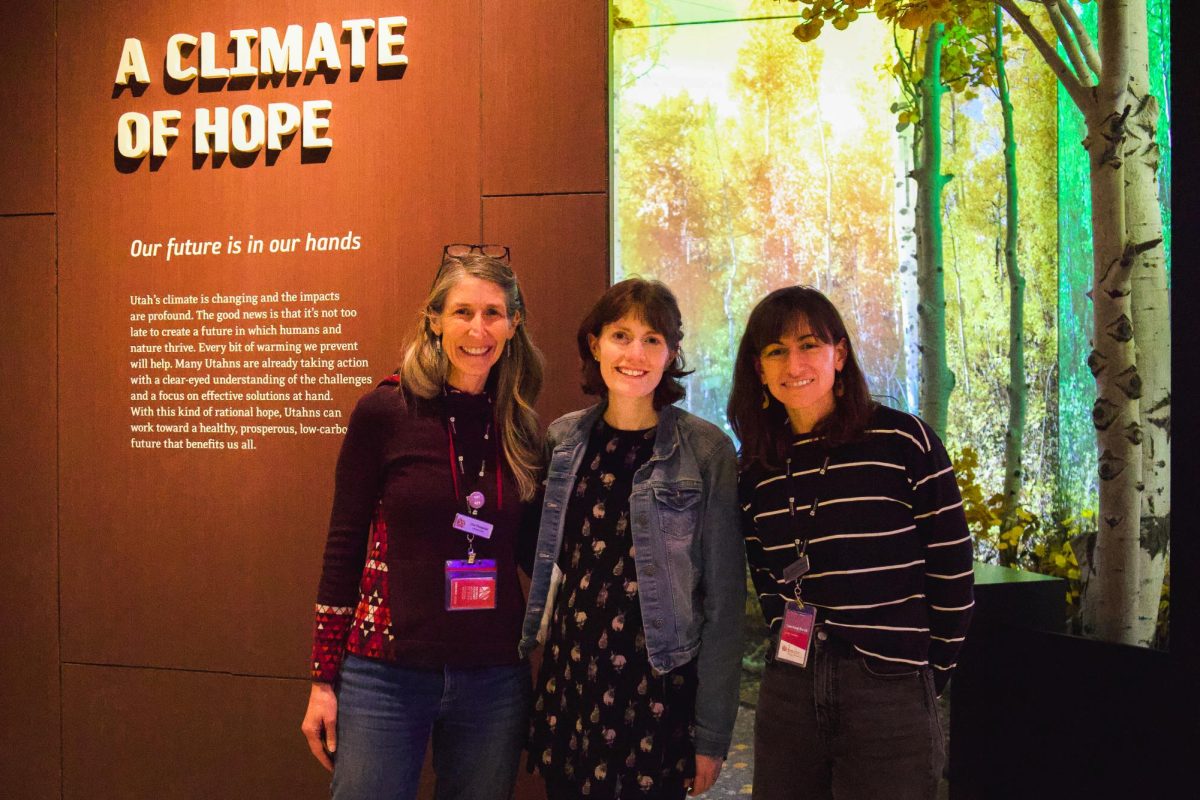The Natural History Museum of Utah has opened “A Climate of Hope,” a new exhibit to inspire optimism and action for a better future in the face of climate change.
Exhibit developer Lisa Thompson said they took a unique approach to “A Climate of Hope” compared to other exhibits focused on climate change.
“Typical museum exhibits about climate change were very data heavy, and they tended to be very gloomy … and they tended to often focus on faraway places,” Thompson said. “And we know from the field of climate communication research that’s been growing … that those just aren’t very effective ways to help people learn about climate change or to help them know how they can be part of climate solutions.”
The interactive exhibit shows how climate change impacts Utah and how people around the state are implementing solutions. Visitors are shown volunteer opportunities they can take part in to combat climate change at the local level.
“A Climate of Hope” is the first permanent exhibition at the NHMU in 12 years. Thompson said development on the exhibit started in 2019.
“[We did] interviews and surveys with visitors to understand what they know about climate change, what they feel about climate change and what they would like to see in the climate change exhibit,” Thompson said. “We did that just before the pandemic shut everything down.”
Jason Cryan, executive director of the NMHU, said the exhibit is a part of the museum’s larger climate initiative.
“The ‘Climate of Hope’ initiative also includes large-scale sustainability measures,” he said. “We’re trying to see what it’s going to take to make this a net-zero carbon neutral operation. We have several research programs that are kind of aimed at sustainability, biodiversity and those kinds of things, so all of this wraps up under a very big umbrella.”
Lynne Zummo, the curator of learning sciences at the NHMU, is conducting a four-year study to see how people respond to the exhibit’s message framing.
“The whole goal of the research is to understand the learning processes that people go through as they’re experiencing the exhibit,” Zummo said.
Zummo added participants in the study will view the exhibit strapped with cameras and recorders.
“We’ll look for themes and patterns across groups and really try to unpack what are the different influences that come into play in learning around climate change in the exhibit,” Zummo said. “Because it is a very different learning process than around other science issues.”
After seeing the exhibit, the participants will complete a survey to learn how they cope with climate change, followed by an interview a few weeks later. The exhibition will adjust its messaging in response to the study’s results.
“We’re excited to see if it helps people feel a little more hopeful, feel like they can take meaningful action, and feel like Utah is a place where a lot of really cool things are happening,” Thompson said. “And then we’re going to find out, which I think is a really unique part of this project, that what Lynne learns is going to help museums … and people all over the country better develop theories and ways of teaching about climate change.”
The exhibition is open daily from 1o a.m. to 5 p.m. and is extended to 9 p.m. on Wednesday. It is free for University of Utah students, faculty and staff.





John Hedberg • Dec 28, 2023 at 10:49 pm
I feel what you’re writing about. Regarding “existential dread” about Climate Change, we’re not alone. During the 1950’s, 60’s, 70’s, and 80’s, students lived under the dread of impending Nuclear War, which was expected to obscure sunlight and lead to Nuclear Winter, a different kind of climate change that also included radioactive fallout and horrific birth defects among any survivors. It didn’t happen, but people were sure scared!
Tools to help us?
1. There’s something viscerally natural and positive about in-person socializing. Turn OFF your phone. Spend time with people and friendly animals.
2. Go for a walk. Exercise (and sunlight) stimulates areas of the brain which resist and reverse depression & anxiety. The seasonal colors are very stimulating. Get a group together, and go for walks outdoors several times a week. We’re literally right next to premium mountain trails. You’ll breathe better, that’s for sure!
3. Sing. Play an instrument. Listen to live (acoustic) music. These tap something deep and pleasing on both an emotional and intellectual level, and it’s another reason to be together in person. You’ll feel more relaxed.
4. Go to a dance. It’s fun, it’s exercise, it’s social, and you’ll be making your body more oxygen-efficient with every step, so you’ll sleep better. You may even laugh!
5. Pray/meditate/connect with spirit. If you can find and connect with a Greater Love through meditation or prayer, you’re no longer alone, and there’s a reason to smile every time you close your eyes.
6. Try looking at the bright side of global warming. Emerging data indicates that the dynamics of change have been hugely exaggerated, and warming will be both slower and milder than previously anticipated. Most of the planet’s land is Arctic permafrost, so the Great North (Canada, Greenland, Russia) is beginning to turn green, and those new plants LOVE CO2 levels. We can transport wildlife and agriculture North over a generation or two, and by the time we’re having our 50th Wedding Anniversaries, our grandkids will have stabilized or even reversed temperature vectors, and we can celebrate together at the new beach house in Thule.
So many fears in my parents’ generation turned out to be OK, despite all students’ worst expectations, so seek the fun and enjoyment in life and each other (phone OFF) while we work and grow together, and burn off stress having a good time together while we solve a few life puzzles, like every new generation does. Deal?
Luiz Manzo • Dec 28, 2023 at 11:08 am
Great article Giovani 👏👏👏